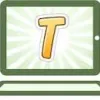Take a look inside 6 images
Typing Quest
Pros: Attractive interface, comprehensive lesson range, and controls for teachers.
Cons: Limited content per lesson, and the games are sometimes a bit confusing.
Bottom Line: Typing Quest turns beginner keyboarding students into fluent touch typists, with a little extra effort from teachers.
Typing Quest is designed for entire classes or schools and has single sign-on (SSO) and LDAP integration. When teachers or administrators are logged in, the site is broken up into a Manager side, where teachers can adjust the settings, and a Study Area side, where teachers can see the lesson modules. Teachers can organize students into special groups relating to class, age group, and language proficiency. They can also adjust the course to accommodate each group's needs (such as words-per-minute, or WPM, targets; length of lesson; and use of the Backspace key), track and assess student progress, and add special texts for the typing tests, to cover topics studied in other classes or add in foreign language support. Additionally, versatile reporting tools help teachers track their students from a number of perspectives, including evaluating whether struggling students are likely to pass the final course tests. If teachers get stuck, the site includes thorough files for both user and manager manuals in several languages. Typing Quest is also available on tablets, with or without an external keyboard. For younger or beginner students who have access to tablets, there are also some games available to familiarize them with the keyboard layout.
Typing Quest is a full typing curriculum for grades 1-12, beginning with keyboard configuration layout and typing the home row, and ending with the typing of information-rich, multi-paragraph documents, special characters, and 10-key. The course includes up to 20 hours of exercises, customizable typing tests, and five typing games. A collection of teacher tools lets teachers set requirements for different student groups and provides support for multiple languages. In addition, there's a pretest and a long list of self-assessment tests to gauge learning along the way. Custom text for tests can also be added.
The curriculum's three main modules start with introductions and initial tests and then move into the home row study before covering other parts of the keyboard. Keyboarding Kickstart gets young kids to use both hands and all 10 fingers individually. There's a color-coded keyboard for students to follow, and fun games keep young kids interested. Many of the instructions are read aloud, and students can follow along on the screen. Typing Quest Junior is for mid- to late elementary students and covers the entire alphabet and common punctuation. Typing Quest is for middle school and up and includes longer and trickier words. Lessons include warm-up exercises and an exam. Keyboarding Kickstart and Typing Quest Junior also have visual guidance slides that cover proper touch-typing technique and ergonomics. The curriculum's four more-specialized modules focus on increasing typing speed, the number row, special symbols, and the 10-key number pad.
Following each exercise, students get to see a visual scorecard that shows them their speed and accuracy scores, and trouble words are tracked for later practice. At any time, typing tests can be taken to evaluate typing skills. Fast typists may find a slight delay when they finish typing one page of text before the next appears, which may affect their overall typing speed score. Unlike in the lesson exercises, typing mistakes don't stop students from progressing through the text; errors are merely reflected in the student's final score.
As with most typing programs available, Typing Quest will teach students proper keyboarding form and habits while giving them extensive practice, starting with the home row and adding other sections of the keyboard slowly. The lessons have color-coded and connected on-screen keyboard keys that demonstrate which keys are to be pressed by which fingers. This helps students of all ages visualize just how the keyboard real estate is covered by their hands. The colorful interface makes for a pleasant learning environment, and the games extend the learning and add to the fun while taking the pressure off. The games lack a bit of polish and aren't all intuitive, but they are a nice break from straight typing. Since Typing Quest is designed to allow teachers to adjust courses, threshold requirements, and more, it's easy for lesson modules to be tailored for students as needed.
Struggling students can review words they have more trouble typing, while fast and accurate typists can be challenged with teacher-created text at higher reading levels. While the whole keyboard is covered on the site, it could be improved with more variations on the lessons. As it's currently set up, exercises don't offer a lot of variety, and faster typists will find that exercise content repeats itself. Teachers can create original testing material, but there seems to be only one lesson or a few exercises per focused topic. Additionally, in some places, it's particularly difficult to differentiate between a capital letter I and a lowercase L. A different typeface would alleviate this confusion.















